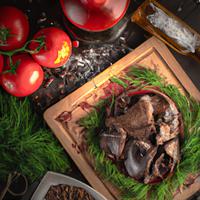
1 serving (100 grams) contains 175 calories, 25.8 grams of protein, 6.2 grams of fat, and 5.1 grams of carbohydrates.

Log this food in SnapCalorie

Nutrition Information
Calories |
416.7 | ||
|---|---|---|---|
% Daily Value* |
|||
| Total Fat | 14.8 g | 18% | |
| Saturated Fat | 5 g | 25% | |
| Polyunsaturated Fat | 0 g | ||
| Cholesterol | 1342.9 mg | 447% | |
| Sodium | 166.7 mg | 7% | |
| Total Carbohydrates | 12.1 g | 4% | |
| Dietary Fiber | 0 g | 0% | |
| Sugars | 0 g | ||
| protein | 61.4 g | 122% | |
| Vitamin D | 119.0 mcg | 595% | |
| Calcium | 26.2 mg | 2% | |
| Iron | 15.5 mg | 86% | |
| Potassium | 547.6 mg | 11% | |
* Percent Daily Values are based on a 2,000 calorie diet. Your daily values may be higher or lower depending on your calorie needs.
Food Attributes
Source of Calories
About Fried liver
Fried liver is a classic dish often enjoyed in various global cuisines, including European, African, and American traditions. Typically made with thin slices of beef, pork, or chicken liver, it is pan-fried in oil or butter and seasoned with spices like salt, pepper, and garlic. Some recipes incorporate onions or herbs to heighten flavor. A rich source of essential nutrients, fried liver provides high levels of iron, vitamin A, and B vitamins, supporting immune function, energy, and vision health. It’s especially beneficial for those with iron-deficiency anemia. However, liver is also high in cholesterol and saturated fat, so moderation is key, especially for individuals managing heart health. Pairing it with healthy sides like steamed vegetables or whole grains can balance nutritional intake. Fried liver’s robust flavor and nutrient density make it a popular choice for those seeking comforting, traditional fare packed with health benefits.



